

ILLUMINATED: LIGHTSCAPE RETURNS HELP SAVE OUR RAINFORESTS FORMIDABLE FUNGI



ILLUMINATED: LIGHTSCAPE RETURNS HELP SAVE OUR RAINFORESTS FORMIDABLE FUNGI
On a steamy subtropical day in 2002, I approached the entrance gates of a picturesque tree nursery in the New South Wales North Coast hinterland. I had been given the enviable task of being sent to select most of the 30 young specimens slated to replace 11 ailing trees, which had been earmarked for removal from the western side of the Domain – where there were perfect growing conditions for figs and Araucaria species. I selected 10 white figs (Ficus virens) and 10 hoop pines (Araucaria cunninghamii). These were marked, set aside and grown on for the next couple of years, until ready for shipment for the planned replacement in 2004.
Following a protracted and controversial removal process –which involved a public consultation process, stop-start operation, much media attention and a well-publicised court case – the old trees were finally removed in winter 2004. Subsequently, 30 planting locations were marked, referencing planting patterns from the time the Domain was originally set out in the 19th century. The ground was then prepared for planting in September, trees were planted –including 10 additional Washingtonia palms (Washingtonia robusta) – and irrigation was also installed. The trees established rapidly and soon adapted to their new surroundings.
Over the last 20 years, the trees have made a wonderful impact, and show how long-term planning of urban landscapes has had such a positive influence on our well-loved Domain and, more widely, our urban forest. David Bidwell, Consulting Arborist, and proprietor of Rainbow Tree Consultancy. Former Senior Arborist Royal Botanic Gardens and Domain, 1993–2017




Springtime signals the return of Fleurs de Villes to Sydney, as the sun shines brighter, and flowers burst into bloom. Prepare for the enchanting journey of VOYAGE, as Fleurs de Villes graces The Calyx at Royal Botanic Garden Sydney from 9–18 August 2024.
Following its global tour, including stops in New York, Vancouver and Toronto, VOYAGE arrives with 15 breathtaking floral mannequins, each a unique masterpiece crafted by Sydney’s finest florists. These botanical creations will transport you to worldwide destinations, offering a cultural odyssey through the language of flowers.
Immerse yourself in this floral extravaganza at your own pace, or be inspired with talks and demonstrations by expert florists and horticulturists. Indulge in treats from the Leaf Dept. Cafe amid the floral splendour, and cast your vote for the most captivating mannequin.
Join us as The Calyx transforms into a garden of wonder and creativity from 9–18 August. Tickets are available now at botanicgardens.org.au/whatson/fleurs-de-villes-voyage. Don’t miss this floral voyage of discovery. For more information, see the Diary, page 31.
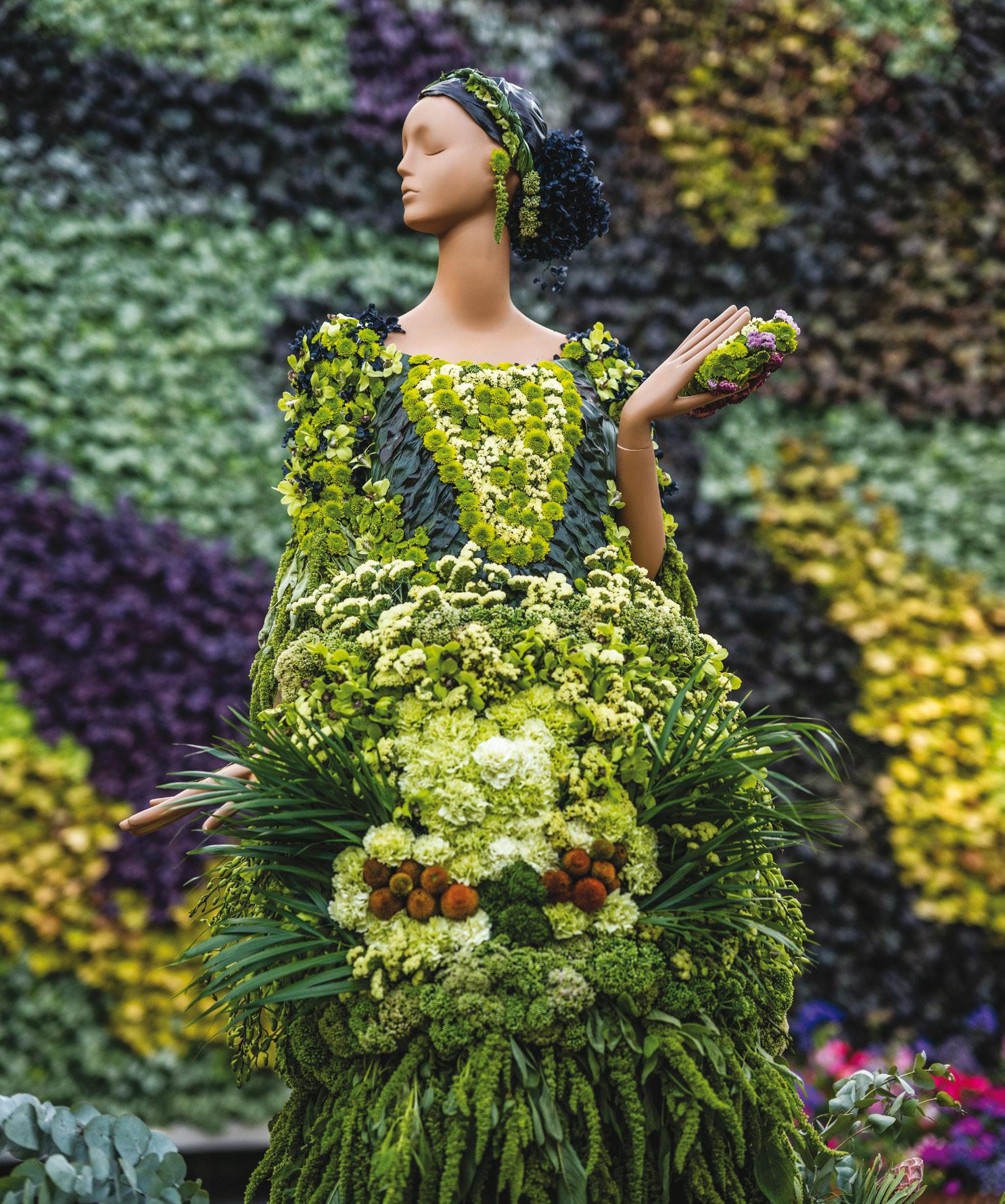
Minister Paul Scully recently announced that the future of Botanic Gardens of Sydney will be expertly guided by a new Chief Executive, following a competitive global search.
Simon Duffy AM will join the Gardens from Taronga Zoo, where he has spent the last 27 years leading education, tourism, science, conservation, place-making and fundraising initiatives. Mr Duffy also successfully led Taronga’s
transformation from a traditional zoo to a zoo-based conservation organisation. The appointment is aligned with, and reinforces, the Gardens’ position as a global leader in biodiversity, sustainability, scientific research and conservation, as well as the significance of Botanic Gardens of Sydney as iconic and cherished destinations for families, naturelovers, scientists and tourists alike. Mr Duffy brings to the role exceptional experience and a visionary approach
to creating and communicating biodiversity projects on a local, national and international level.
In 2019, he was appointed a Member of the Order of Australia (AM) in recognition of his work in conservation in both Australia and Africa. Mr Duffy has stated he is ‘extremely excited to be joining the wonderful team at Botanic Gardens of Sydney’ and will commence as Chief Executive on Monday, 3 June 2024.
The Board of Foundation & Friends is proud to advise that two new Life Members were recognised at our most recent Annual General Meeting in November 2023. We acknowledged Robert Constable for his significant contribution to the Botanic Gardens of Sydney over many years, and most recently for his vision and dedication in bringing to life the wonderful new Amphitheatre in the heart of the Royal Botanic Garden Sydney. Robert and his family’s unwavering support will ensure future enjoyment of the Gardens by both garden lovers as well as students of the Conservatorium of Music.
In addition, we acknowledged a dedicated and long-term Waratah member and supporter, who has made considerable contribution to our community, and has chosen to remain anonymous. This individual, together with their family, has been a steadfast supporter of Foundation & Friends for years. Their generosity has been invaluable in promoting various areas across the gardens, enhancing our mission locally and globally. They were humbled by the Life Membership, and thanked the organisation for this meaningful acknowledgement.
Foundation & Friends are excited to confirm that our annual scholarship program will recommence for the 24/25 year. Available to all permanent employees of the Botanic Gardens of Sydney to focus on professional development, funds can be used for attendance to scientific conferences, study trips and work placement. Past recipients report that these scholarships have been life changing – both for the ideas they bring to the Gardens, and the experiences the recipients enjoy. After a hiatus due to the pandemic, available funds have been doubled to $60,000. Made possible by the amazing generosity of our donors and members.

Growing up in the northern suburbs of Melbourne, my family would escape the city most weekends and head to the bush. Our sport was orienteering, which introduced me from the age of five to the forests of Victoria, and later to landscapes across a wide part of Australia. As a junior I did win a couple of races, but what I most take away from that period of my life was how the experience connected me to our incredible and diverse natural landscapes.
I probably would have won more races had I not been so interested in the plants and environments the sport immersed me in. I was particularly fascinated by the small pockets of lush green temperate rainforests that you find not far from the urban fringe of Melbourne. These are magical places filled with tree ferns, mosses and spectacular trees – and the occasional leech – and were so far removed from my weatherboard home.
Now, as an adult, I know that these special places are rare, and they are also endangered. They contain an enormous and rich diversity of life, including plant species that you will find nowhere else.
Since those childhood days of running through the bush, the threats have only intensified to Australian rainforests. In the 1970s and ’80s climate change was only just beginning to be understood, and the lethal plant pathogen of myrtle rust had yet to reach our shores.
Foundation & Friends is focusing on Australia’s threatened rainforest for our end of financial year appeal. Protecting these landscapes has never been more urgent. The incredible work of Botanic Gardens of Sydney in rainforest conservation is emblematic of the huge impact they are having on plant protection and survival. We are proud to have recently donated over $600,000 in vital equipment for research at the Gardens, including funds for a number of projects that will help secure the future of our rainforest species. I would like to thank all of our supporters who have contributed to the rainforest conservation work of the Gardens. It is through these gifts that we can ensure a new generation will be able to discover the magical and special world of our rainforests.
Pete Thomas, CEO Foundation & Friends

Our vital work to protect and conserve plants was the inspiration behind The Florilegium Society’s Rainforest Species at Risk – our recent inaugural exhibition at The Garden Gallery in the refurbished Robert Brown Building at Royal Botanic Garden Sydney.
The exhibition featured exquisite early 20th century illustrations by Margaret Flockton, our first botanical illustrator, as well as recent work by our current botanical illustrators Lesley Elkan and Catherine Wardrop. Together, the remarkable works demonstrated the need to secure the future of Australia’s fragile and important ecosystems amid the climate crisis – an important part of our mission.
One way we seek to achieve this is by preserving ex-situ collections of plants for posterity – such as at Blue Mountains Botanic Garden Mount Tomah, where work is underway to create a new Camellia Garden. The exciting project aims to showcase the beauty of the cultivated varieties while preserving rare camellia species (and other members of the camellia family, Theaceae), which are sadly facing extinction in the wild due to threats including climate change,

agricultural clearing, lack of genetic diversity and excessive – and often illegal – harvesting.
Despite some wet-weather challenges, the project has progressed apace. At the time of writing, excavation works have revealed the rolling contours of the landscape, lookouts, secluded garden rooms and a network of paths; while natural bluestone retaining walls have been used to enhance beauty and connect visitors to existing gardens.
It’s an important opportunity to tell the story of these plants and communicate the importance of protecting them – a mission that sits at the heart of what we do, across all our sites.
With this in mind, we are excited to welcome Lightscape back to Royal Botanic Garden Sydney for its second year, as part of Vivid Sydney 2024. The immersive event takes visitors on a multi-sensory journey of light, colour and sound, designed to enhance appreciation of the Garden and highlight the wonders of our extensive horticultural collections.
Transforming the Robert Brown Building, creating The Garden Gallery, hosting remarkable exhibitions, investing in showcase conservation projects like the Camellia Garden, and inviting engagement through immersive experiences such as Lightscape, are just some of the many ways we continue to enrich visitor experiences and creatively demonstrate the importance and urgency of protecting plant species. Of course, none of this would be possible without the vital support of Foundation & Friends of the Botanic Gardens.
Professor Brett Summerell, Acting CE, Botanic Gardens of Sydney
The three-year term of one of our Directors on the Board of Foundation & Friends expires at the 2024 Annual General Meeting. Consequently, the Board Nominations Committee is undertaking a recruitment process and is calling on members who may be interested in nominating for the role.
The Board of Directors is responsible for managing the business of Foundation & Friends and the Trust Funds. All Directors should have a demonstrated genuine interest in the organisation and bring with them a level of knowledge and experience commensurate with the position.
To ensure the appropriate Board skills composition as we deliver our five-year strategic plan, we are particularly seeking nominations from individuals with the following skills:
• Philanthropy and fundraising
• Marketing, communication, media and advocacy
• Human resources and people management
• Accounting and financial reporting The role of Director is an elected three-year voluntary position. It is important that Directors are able to commit time to attendance of Board, committee and other meetings throughout the year as well as attending events.
To receive a Director’s Information Pack, please contact Foundation & Friends on (02) 9231 8182 or email foundation.friends@botanicgardens. nsw.gov.au. Expressions of interest will need to be submitted by 30 June 2024.
Members are invited to attend Foundation & Friends’ 42nd Annual General Meeting on Tuesday 19 November. Starting at 5.30 pm in Gadi Room, Robert Brown Building, Mrs Macquaries Road, Sydney.
FROM 1829 – 1832, DANISH BOTANIST NATHANIEL WALLICH WORKED WITH A TEAM OF HIGHLY SKILLED INDIAN BOTANICAL ARTISTS TO PRODUCE THE THREE-VOLUME PLANTAE ASIATICAE RARIORES (RARE ASIAN PLANTS). MIGUEL GARCIA REPORTS.

In the early 19th century, global networks were established through correspondence. These networks were the primary means through which new scientific knowledge was communicated.
In the burgeoning British Raj of India, there was an increasing scientific and horticultural interest in learning more about the subcontinent’s plants. At that time, there were few books on the flora of India. Prior works on some of the flora existed, such as the 17th-century Hortus Malabaricus (see the Autumn 2024 issue of The Gardens), but they lacked the context of the latest science, such as Linnaeus’s classification system.
Between 1829 and 1832, a lavishly illustrated three-volume work was published by the talented Danish botanist Nathaniel Wolff Wallich (1786 – 1854) Plantae Asiaticae Rariores (Rare Asian Plants), which highlighted many hitherto unknown Indian plants.
Nathaniel Wallich was of Danish origin, born in Copenhagen in 1786. In 1803 he attended the Royal Academy of Surgeons, where he was trained in the botanical sciences – a necessary adjunct to medicine in that era. In 1806 he was appointed surgeon to the Danish settlement at Serampore, in Bengal. Due to the vagaries of the Napoleonic Wars, Serampore was seized by the British in 1807, and Wallich imprisoned until his release in 1809 in recognition of his skills.
By 1813, now interested in the flora of India, Wallich undertook expeditions to Nepal, West Hindustan and lower Burma.
He entered the service of the British East India Company in 1814 and was appointed assistant to William Roxburgh, the East India Company’s botanist in Calcutta.
Wallich helped found the Oriental Museum of the Asiatic Society in 1814. He was appointed first honorary curator and, soon after, superintendent. The museum grew rapidly under Wallich’s guidance, encouraging donations from private individuals, including himself.
Wallich held the position of Superintendent of the Calcutta Botanic Gardens from 1817–1846. He prepared a catalogue of more than 20,000 specimens, which were either collected by Wallich himself or by other collectors from around the same period.
One of Wallich’s greatest contributions to the field of plant exploration was the expansion of his predecessor’s
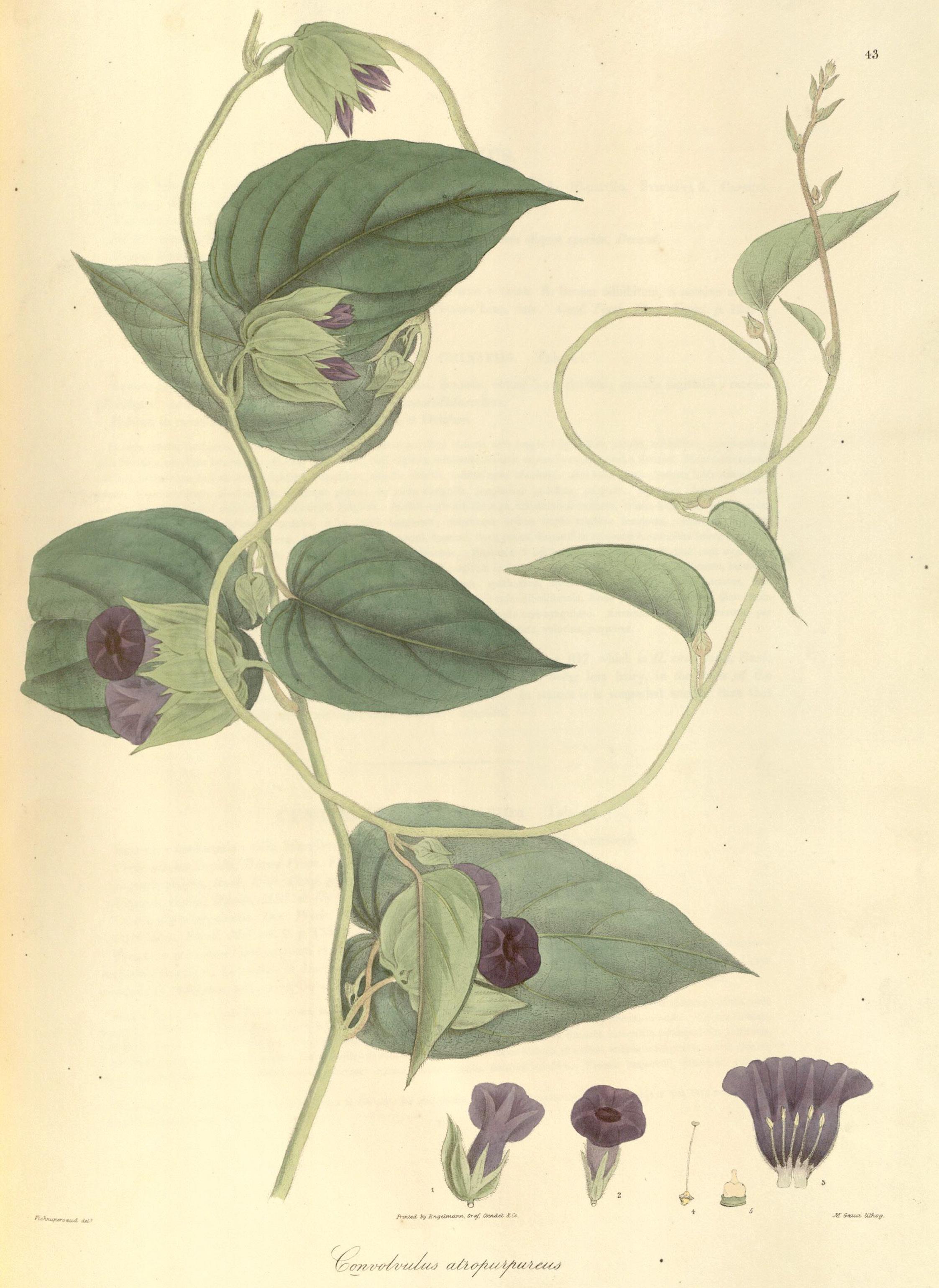 Photos: Daniel Solander Library
Photos: Daniel Solander Library
program of using the Garden as a base to explore the flora of India. His assistance was invaluable to the many plant hunters who stopped in Calcutta on their way to the Himalayas, including Joseph Dalton Hooker – later Director of Kew and a great friend of Charles Darwin. In 1822, at the behest of his friend Sir Stamford Raffles, Wallich travelled to Singapore to design its botanical garden, returning to Calcutta the following year.
Apart from undertaking numerous botanical expeditions himself, Wallich also published two books, the most important being Plantae Asiaticae Rariores. The latter was published in London, Paris and Strassburg between 1829 and 1832 it consisted of three volumes bound from the 12 original parts in folio size, with each part selling at £2 10s.
Wallich recognised that the public knowledge of Indian plants did not match the accelerated discovery of new species from Asia. As such, a work deserved to be accurate and informative, meriting the best attention with respect to the depiction of Indian plants and would be extremely expensive to produce. It would also represent the fruits of Wallich’s long experience in India, abundantly justifying the production of such an ambitious publication.
Wallich solicited the British East India Company for funding and dedicated the work to its Directors. As a result, it was sponsored by the Company, who subscribed to 50 copies of the 250 printed. However, Wallich knew he would need to source more subscribers to cover the enormous cost of publication. He used all channels of his large network of contacts and approached not only professional naturalists, but wealthy landowners and aristocrats with interests in botany and horticulture. The method proved successful, as can be seen from the lengthy list of European and Indian subscribers in the first volume, including royalty, great libraries, universities and botanic gardens.
Wallich went on extended leave in 1828 to supervise the printing and handcolouring of the illustrations in England. He began with the preparation and arrangements with the printers of the plates, Engelmann, Graf, Coindet & Co.,
and especially the Maltese artist Maxim Gauci, who transferred the Indian artists’ drawings to the lithographic stones.
The work was enormous, both in its scale of large folio and the richness of its content, containing detailed Latin plant descriptions and short notes in English on the localities of the plants depicted, as well as a double-page map of India inscribed with the expedition routes of Wallich himself and of other botanists.
The three volumes of Plantae Asiaticae Rariores made use of a team of artists employed by the Calcutta Botanic Garden which, by 1827, numbered 20. Of the 294 illustrations, the majority were composed by native Indian artists; 81 were by Gorachand and 114 by Vishnu Prasad (also known as Vishnupersaud).

Although Wallich is well known for having credited his artists when publishing their work, he only ever named Gorachand and Vishnu Prasad. These two were undoubtedly the master artists; the juniors working under them received little credit. However, Wallich built long-term relationships of trust with the artists, especially chief draughtsman, Vishnu Prasad, who had worked at Calcutta since 1815 and accompanied Wallich on many expeditions. Vishnu Prasad was frequently employed by naturalists working in India, such as John Forbes Royle and Francis Buchanan-Hamilton. Vishnu Prasad’s skill was exemplary and memorable.
Wilfrid Blunt included one of his watercolours in his book The Art of Botanical Illustration as displaying great skill.
Vishnu Prasad and the other Indian artists were educated in the Mughal style of botanical illustration. The Mughal emperors were genuine nature-lovers, and under their rule the Persian tradition of lavish gardens and love of flowers was directed into scientific pathways. The Emperor Babur (1483 – 1530), the first Mughal, shows in his memoirs, the Baburnama, the intense pleasure that he took in the appreciation of the aesthetics of flowers, leaves, their structure and colours. Though not himself an artist, Babur clearly showed his appreciation of the depiction of botanical art, its accuracy and skill; writing about an apple tree in late autumn:
On each of its branches five or six scattered leaves still remained, exhibiting a beauty which the painter, with all his skill, might attempt in vain to portray.
Under Babur’s descendant, Jahangir – himself an enthusiastic naturalist –there emerged a school of botanical illustration that was the equal of the emerging great masters in Europe. Though much of the surviving art is zoological in nature; Jahangir’s memoirs, the Jahangirnama, record that his favourite artist, Mansur, made more than 100 botanical studies in Kashmir alone. During the 18th century as the Mughal Empire declined, Indian painters formerly under Mughal patronage sought work from the Hon. East India Company, many of who were eager collectors of drawings of Indian plants and animals. Many hundreds of magnificent drawings made by Indian artists during the early part of the 19th century, under the direction of British botanists such as Wallich, are now in institutions around the world.
Vishnu Prasad’s works in Plantae Asiaticae Rariores give but a slight idea of the patience and fine craftsmanship displayed by these Indian painters who have made an original and very real contribution to botanical art.
CAN URBAN FORESTS REALLY HELP US KEEP OUR COOL?
The importance of resilient and sustainable urban forests is recognised globally. UN Sustainability Development Goals call for additional tree cover in cities to supply essential environmental, economic and social ecosystem services. Urban forest strategies at scales from local councils to global mega-cities are being rolled out. In NSW for example, the State Government’s Greening our City program aims to increase green cover across Greater Sydney and contribute to lifting urban canopy coverage to 40 per cent by 2036.
The urban forest, or green infrastructure, incorporates public parks, residential gardens, street trees,
remnant bushland, green roofs and walls, and stormwater management systems such as rain gardens. The ecosystem services and benefits provided by urban forests are enormous. The urban forest is increasingly seen as a viable tool in helping cities to mitigate climate change through carbon sequestration and storage and, most importantly, to adapt to extreme heat. Urban vegetation actively cools the landscape through evaporation and shading, resulting in reduced temperatures and flow-on benefits of reduced energy use and risk of heat stroke in vulnerable people. Green space is used in water-sensitive urban design to control flooding, erosion and nutrient loading and to absorb and
trap air pollution. The urban forest provides critical habitat for biodiversity and there is increasing evidence that access to urban green space is associated with improved health and wellbeing outcomes for people. However, given climate-change predictions that Australian cities will face hotter temperatures, increased frequency and severity of drought, more-intense and more-frequent storms and bushfires, and potentially new pests and pathogens, there is an urgent need to ensure our urban forests are resilient for the future. We can build the resilience of our urban forests through careful selection and management of plant species, ensuring that the species of our urban forests

As climate change intensifies, we need to find innovative ways to adapt our cities to the new conditions.
are adapted for future climates, with tolerance of hotter and drier climates. There are two large field experiments currently underway at the Australian Botanic Garden Mount Annan aimed to find ways to future-proof Sydney’s urban forest. The first experiment is a collaboration between Botanic Gardens of Sydney and Macquarie University. The Botanic Gardens received funding from the NSW Government through the Greening our City program to clear the existing forest of invasive African olive and plant 22,500 trees by July 2022. The planting has been done in three stages through 2021–2022 – a mammoth effort! Within the large planting are embedded several research projects, including the project led by Macquarie University. This project comprises 1600 plants representing 10 tree species native to the Sydney region that are commonly planted in urban green space. For each species there are two provenances – one local to western Sydney and the other from a hotter and drier population within the species’ natural range. The trees are planted across two sites types (north-facing – dry, south-facing – less dry). The experiment is also testing whether the addition of soil amendments (biochar and microbial additive) can improve tree performance. All the trees were grown from seed in the nursery at ABGMA and were planted in spring 2022. They are each individually tagged and are monitored every three months, where their height and stem diameter are recorded, and a visual assessment of tree health is made. So far, the trees are doing well, with some over 2 m tall now – although the local kangaroos had to be deterred from eating the new growth by installation of chicken-wire tree protection! This project was designed and developed by Professor Michelle Leishman and Dr Anthony Manea from Macquarie University, in collaboration with Botanic
Gardens of Sydney scientific and horticultural staff. It will form a large part of Sashini Perera’s PhD research, which will be finalised at the end of 2025.
The second large field experiment is a collaboration between Macquarie University, Sydney Water and Botanic Gardens of Sydney, with additional funding from the NSW Greening our City program. The lead researchers from Macquarie University, Professor Michelle Leishman, Dr Anthony Manea and Dr Samiya Tabassum, are supported by Dr Heather Lacey and Dr Marie Enfrin from Sydney Water Research and Innovation team, and John Siemon and Michael Elgey from Botanic Gardens of Sydney. The project is testing the impact of recycled water, provided by Sydney Water, on different tree species, with a focus on western Sydney’s unique soil and landscape challenges. At the Australian Botanic Garden field site, 600 trees have been planted incorporating 15 commonly planted native species of western Sydney. The trees are watered with either potable or recycled water, with or without biochar as a soil amendment. All the trees are individually tagged and the site is monitored using state-of-the-art sensor technology. Real-time dashboards allow
the researchers to monitor soil moisture and salinity to 1 m depth, as well as air temperature and humidity. Sap flow sensors are installed in the growing trees to monitor tree water use, and tree growth is recorded every three months.
The outcomes from this experiment will be important for managing green space and cooling in western Sydney. Using recycled water for green space management seems like a simple solution to a hotter and drier climate, but we need to be sure that the chosen tree species perform well with recycled water and that irrigation using recycled water doesn’t create salinity challenges. The project will help develop a ‘recipe for recycled water use’ for water authorities, planners and landscape architects. As well, educational material on urban greening, climate change and water use will be produced as part of the project. As climate change intensifies, we need to find innovative ways to adapt our cities to the new conditions. Collaborative research projects such as these help to provide the evidencebase for smart decision-making for urban forest and green space management, ensuring that cities of the future support healthy, liveable environments for people and nature.
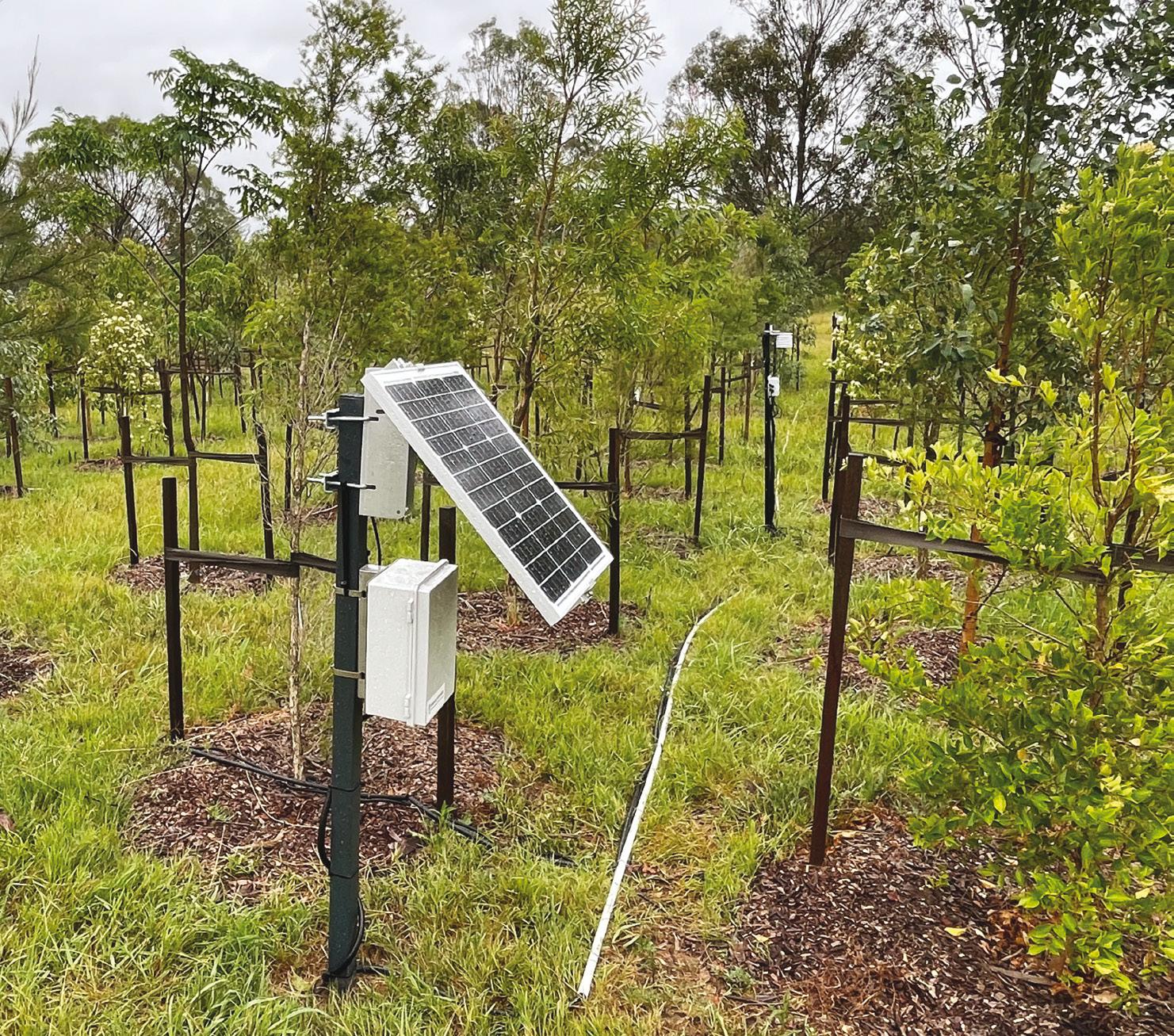
DR KAREN SOMMERVILLE
AUSTRALIAN PLANTBANK, BOTANIC GARDENS OF SYDNEY

 Dr Karen Sommerville bags a fruiting branch of scrub turpentine (Rhodamnia rubescens) as part of a breeding project for myrtle rust resistance in the Nursery, Australian Botanic Garden Mount Annan
Dr Karen Sommerville bags a fruiting branch of scrub turpentine (Rhodamnia rubescens) as part of a breeding project for myrtle rust resistance in the Nursery, Australian Botanic Garden Mount Annan
Australian rainforests harbour an incredible diversity of plants. Although they occupy a very small percentage of the continent, they hold more than 3500 seed-producing species and hundreds of ferns, mosses and liverworts.
These plants in turn provide habitat for an amazing diversity of animal species – from the beautiful Ulysses butterfly to tropical tree kangaroos and the weirdly wonderful cassowary.
When Europeans arrived in Australia, rainforests were seen as a fantastic resource for timber and agricultural land. In some regions of New South Wales and Queensland, this meant they were cleared to such an extent that very little remains. In an area known as the Big Scrub in Northern New South Wales, for example, 75,000 hectares of continuous subtropical rainforest were reduced to just 100 hectares of rainforest fragments by the early 1900s. Many of the rainforest habitats remaining are now listed as Endangered Ecological Communities.
The plants within those remnants face the ongoing consequences of land clearing, and the added pressures of a changing climate and introduced diseases. Fragmented populations have diminished genetic diversity, and reduced opportunities for cross-pollination, which can lead to poor regeneration. The increase in exposed forest edges can lead to changes in microclimate, furthering the risk of drying out in periods of drought and increasing the risk of fire. Climate change is threatening the existence of plants restricted to temperature-sensitive environments like tropical cloud forests, and myrtle rust – a fungal disease introduced to Australia in 2010 – has led to several once-common species being listed as Critically Endangered in a very short space of time. It’s clear we need to work quickly to preserve the diversity that remains.
An important part of the solution to this challenge is seed banking – storing dry seeds at sub-zero temperatures. This is a simple and cost-effective method of conservation for many species, providing insurance against extinction, a source of material that can be used to return species to the wild, and material that can be used for research to better understand how a species will be impacted by a changing environment. In 2008, information on how rainforest seeds would respond to seed banking was sadly lacking so the Rainforest Seed Conservation Project was initiated to fill the gap. Since that time, despite the many difficulties encountered in collecting and germinating rainforest seeds, we’ve shown that around 70 per cent of species tested will tolerate sufficient drying for seed banking.
When a few drying-tolerant species were found to be very short-lived in storage at –20°C, work then commenced to determine why this was the case and what could be done about it. With the help of Drs Ann and Geoffrey Long and other generous donors, we were able to purchase a new piece of equipment – a differential scanning calorimeter (DSC) – that allowed us to see what was happening inside the seeds as they were freezing and thawing. We now know that a short life-span in the freezer is related to oils in the seed, and we can use the DSC to predict which species will be short-lived at –20°C and which alternative storage temperatures will keep them alive for longer. This piece of equipment has reduced the time needed to identify freezing sensitivity from a few years to a few hours!
Over time, the Rainforest Seed Conservation Project has expanded to include the development of living collections, tissue cultures, and research into cryopreservation for threatened species that can’t be conserved in the seed bank.
This work has been underpinned by genetic analyses carried out by the Research Centre for Ecosystem Resilience (ReCER).
The team at ReCER have provided much-needed information on how much diversity exists in natural populations, whether the living collections reflect that diversity, and which individuals are most important to preserve – particularly for species severely affected by myrtle rust. Funding provided by Foundation & Friends has enabled the purchase of equipment for ReCER’s newly refurbished laboratories and will ensure this work can continue as efficiently as possible.
The recent donation of a thermogradient plate – thanks to Drs Ann and Geoffrey Long – will enable us to expand our work even further to investigate the effect of climate change on regeneration. Our first pilot study (in collaboration with ReCER) tested the germination of seed from upland and lowland populations of Callicoma serratifolia (black wattle) in response to 21 different temperature combinations. Once analysed, the results will tell us whether some populations are likely to be more resilient to change than others.

The knowledge gained and plant materials conserved through the Rainforest Seed Conservation Project are immensely valuable resources, contributing to local and global efforts to rescue rainforest plants and restore their habitats. Donations made through Foundation & Friends have been key to the development of this project over the years, providing much-needed support for our technical staff and the means to purchase innovative equipment that would not otherwise have been possible to acquire.
We’d like to offer a heartfelt thanks to all donors for helping to keep rainforests thriving for future generations.
The world below the surface of the soil has always been somewhat of a mystery. We know relatively little about what happens there – how microbes, invertebrates, fungi and plant roots interact – and in fact how many different species there are and what their roles are. The estimates of the number of species of bacteria, fungi, other types of microbes and of the invertebrates are mind-boggling and somewhat beyond comprehension. New technology and tools are allowing us to better understand this and providing us with answers to some of these quandaries.
The role that fungi play in the soil in particular is proving to be of great relevance to those involved in the remediation and rehabilitation of neglected and damaged ecosystems, and a great deal of interest has been raised in the broader community as a result of books like Entangled Life by Merlin Sheldrake and recent documentaries such as ‘Fungi –Web of Life’ narrated by Björk.
Fungi play a vital role in maintaining and enhancing soil health. They break down plant and animal matter, decomposing leaves, twigs, branches, stems and roots down to more basic
material that can be taken up by the root systems of plants growing through the soil. Recent research has shown that fungi are capable of breaking down an even broader array of materials –including plastics, petroleum products and other contaminants – and have potential to rejuvenate and rehabilitate severely degraded soil. There has even been some research that shows promise in the use of soil fungi to rehabilitate soil contaminated by nuclear spills and accidents, such as the Fukushima Daiichi Nuclear Power Plant accident.
This latter factor is a process called mycoremediation, which has gained

more and more recognition over the past decade or so. This has been used to rehabilitate soils that have been contaminated with toxic chemicals, depleted of nutrients to the point of being barren and have had their structure completely destroyed. Of particular interest is in the use of fungi to restore mine sites so they can be used to establish something that approaches the original vegetation.
Restoration of the vegetative cover on reclaimed mine lands can be difficult to almost impossible, usually because post-mining soils often have poorly developed soil structure, reduced organic matter and plant-available nutrient contents than the original soils. Often they have been subject to contamination by a variety of chemicals and by the spoilage from the mine itself or from the processes involved in the extraction of the mineral from the ground.
Fungi are increasingly recognised as being important for reclamation of mine sites because of their vital role in nutrient cycling, plant establishment and growth, geochemical transformations, and soil structural formation. A primary function of fungi during soil restoration is to promote organic matter turnover and nutrient cycling through their ability to break down organic matter.
Fungi are the only group of organisms capable of breaking down woody trunks and branches

The enzymes produced by fungi are efficient in breaking down many different pollutants. At heart, this method is about employing fungi’s natural capabilities of decomposition to restore and regenerate land.
The application of the fungus can be complicated – it can be possible to leave nature to do its best and hope that the fungi in the soil naturally proliferate, colonise and break down the substrate. However, this can take some time and it is often much better to supplement by addition of spore suspensions of the fungi, or by the use of colonised timber cores to add to the soil. The oyster mushroom (Pleurotus ostreatus) is often used as it is able to break down a number of substrates, is readily available and easy and quick to grow.
A project I am involved in with Professor Belinda Ferrari at the University of New South Wales, is documenting the species of fungi that are able to survive the environmental conditions in Antarctica. Antarctic fungi species can obviously withstand extreme cold and still potentially provide efficient biodegradation of contaminants. These fungi, collectively known as extremophiles, display an exceptional
ability to exploit all kinds of extreme environments, spanning from hypersaline and acidic sites to toxic, hydrocarboncontaminated sites, glaciers, hot and cold deserts, mountain peaks, solar panels, building roofs, and exposed rocks in polar and alpine regions. If any group of organisms were to be deployed on places like the Moon or Mars it is these type of fungi!
There is great interest in these species as some are able to assimilate and degrade compounds such as those found in crude oil and refined petroleum. Many of the species we are recovering are unique, having never before been scientifically described, and little is known of their potential to break down harmful compounds in these environments, but certainly there is a great deal of evidence that they offer enormous potential to do so.
A question that is often asked is whether these approaches can be used by the home gardener to improve the soil structure and productivity of soils in domestic situations. It is not uncommon for home garden soils to be quite degraded as a result of the processes involved in constructing new home sites, in land clearing and land developments.
There has even been some research that shows promise in the use of soil fungi to rehabilitate soil contaminated by nuclear spills and accidents.
Typically in these cases, the upper soil layer has been removed, along with all of the organic matter, and the soil compacted during construction, resulting in soil that often has difficulty supporting plant growth. Contamination can be common and often difficult to overcome – do fungi offer a solution to these problems? Certainly, many of the standard practices in horticulture –the use of composts, use of mushroom waste and additions of organic matter have at their basis an effort to increase microbial diversity. Supplementing fungal diversity – whether it be Trichoderma fungi to combat root disease or oyster mushrooms to stimulate the speed with which organic matter is cycled – offers much to assist in the creation of resilient and sustainable landscapes.

HAVING AN ORCHID MOMENT? FOR VALERIU RAZVAN PINTILIE, LIFE IS FULL OF THEM. DOM SWEENEY CHATS TO THE SENIOR HORTICULTURIST ABOUT ALL THINGS THAT GROW.
Where did your love of plants begin?
During summer holidays in Romania, where I’m from, we’d go to my grandparents’ and look after and play around their crops. They grew everything – spinach, tomatoes, pumpkins, cucumbers. We didn’t have to buy fruit and vegetables from the supermarket; you just climbed the tree and picked an apricot. That’s what spurred my interest in growing things, and especially seeing my older brothers and sisters studying horticulture; I thought, why not? I spent nine years all up studying horticulture, between high school in Tulcea, and university in Bucharest. There are seven horticulture degrees in my family!
What brought you to Australia?
After finishing my studies in Romania, I took on multiple contracts in the United Kingdom, specifically working on soft fruit farms (strawberries, raspberries, blackberries) and hop farms, as well as hydroponic tomato farms on the Isle of Wight. I moved to Australia in 2006 to study an Advanced Diploma in Management and worked for Flower Power in Mascot as an assistant manager for five and a half years. I really enjoyed learning about native Australian plants – though having to push product to customers kind of took the passion out of it. I joined the Botanic Gardens in December 2014, initially working in maintenance for the Opera House, Art Gallery of New South Wales and New South Wales Parliament House.
Your career has seen you managing a diversity of plants and garden styles. Yes – after finishing my initial temporary work at the Botanic Gardens, I worked for the Office of Environment and Heritage, working on and maintaining heritage gardens around Sydney.
They included 14 museums, as well as the gardens for Vaucluse House, Elizabeth Farm, and Rouse Hill House and Farm. During that time, I learned a lot about garden design in the 1850s and 1870s. After returning to the Botanic Gardens, I worked on the Oriental Garden, and South African garden, as well as the Wildflower Meadow.
Are there any varieties you feel are underrepresented in Sydney gardens? We run the Trial Garden program here, which relies on different nurseries around NSW sending us stock – old stock, or new hybrids – for trialling. One of our horticulturists has been making experimental beds and creating floral displays with all the plants collected from these nurseries, with newspapers regularly reporting on the top 10 plants to grow in Sydney for the year. We always do this kind of research for the public – if you’re looking for something that won’t be thirsty in the summer, or something not spiky, or prolific in flowers, look on this list and you can find it. It covers everything suitable for Sydney’s conditions. The program has been running for five or six years now, by some very knowledgeable people.
You’re now well-regarded as an orchid expert. How did that come about? Five years ago, I had my first opportunity to work with orchids. The collection used
to be just 400 plants, in two glasshouses, and they were not in great condition. If you come and see it now, there are more than 2000 plants – available to see on public tours. I developed the collection with volunteer Peter D’Olier – we buddied up, and make a good team. He’s in charge of reporting and creating mixes for plants, as well as sourcing species we don’t have in the collection, while I look after fertilising, detailing, and creating displays, as well as sourcing plants. It’s a proper, curated collection. I’m really happy with how much has happened in just five years. People who visited the garden 20 years ago, come now and say, mate, it’s a huge jump from what we used to have. The varieties of orchids we have now come from 86 different countries, from a vast array of different types of habitats.
Do you have a garden at home?
No! Just three by five metres of grass (laughs) in our townhouse backyard, and not really any flowers. I’m really busy most weekends driving my 13-year-old around – she’s a very good football (soccer) player and has a lot going on with Western Sydney Wanderers. So, even if I had a garden, I wouldn’t have time to maintain it!
What gets you out of bed every day?
I wake up at 4 am and my first thought is, how are my plants performing and how can I make them perform better?
To look after my babies – my plants! I wake up at 4 am and my first thought is, how are my plants performing and how can I make them perform better? I’m coming here almost every day –sometimes weekends – taking care of my plants and collecting data. At the moment, I’m loving a couple of different projects I’m working on: the flowering calendar is one; another is timelapses – I have two cameras filming non-stop opening of the buds. You can see the timelapses on Instagram or TikTok.

Rainforests, those lush and vibrant havens of biodiversity, harbour secrets that have fascinated scientists, healers and explorers for centuries. With an estimated 80,000–100,000 different plant species found in global rainforests, these species represent a staggering diversity, ranging from towering canopy trees to delicate orchids and vibrant understorey vegetation.
Rainforests play a vital role in maintaining the health of our planet, with their significance underscored by compelling statistics. These ecosystems
are home to over half of the world’s plant and animal species, despite covering only about 6% of the Earth’s land surface. They act as carbon sinks, absorbing vast amounts of carbon dioxide and helping to regulate the global climate. Rainforests also provide essential ecosystem services, such as purifying air and water, regulating rainfall patterns and preventing soil erosion.
Beyond their breathtaking beauty lies a treasure trove of plant species with profound medicinal, culinary and cultural significance. From life-saving medicines to exotic edible spices and
traditional beverages, rainforests offer a cornucopia of resources that enrich our lives in myriad ways, including supporting the livelihoods of millions of people, and are a source of countless medicinal plants. For generations, indigenous peoples have turned to rainforest plants for remedies to ailments ranging from fevers to cancer. Today, modern medicine continues to unlock the therapeutic potential of these botanical wonders. For example, take quinine, derived from the bark of the Cinchona officinalis tree – centuries-old wisdom meets modern science in this potent
generations, indigenous peoples have turned to rainforest plants for remedies to ailments.
anti-malarial drug. Similarly, vinblastine and vincristine, sourced from the Madagascar periwinkle (Catharanthus roseus), have revolutionised cancer treatment, offering new hope to patients battling leukaemia and lymphoma.
But the pharmacopeia of rainforest remedies doesn’t end there. From the muscle-relaxing properties of curare (Strychnos toxifera), the anti-cancer prowess of paclitaxel derived from the Pacific yew tree (Taxus brevifolia), and the tranquillising effects of reserpine from Indian snakeroot (Rauwolfia serpentina), the list goes on. Each discovery is a testament to the untapped potential of these biodiverse ecosystems.
Beyond their medicinal prowess, rainforests tantalise our taste buds with an array of exotic flavours and aromas. From the subtle sweetness of vanilla (Vanilla planifolia) to the fiery kick of black pepper (Piper nigrum), rainforest spices have found their way into kitchens around the world, adding depth and complexity to culinary creations. Cinnamon comes from the inner bark of several tree species belonging to the genus Cinnamomum, cardamom is a spice made from the seeds of several plants in the genera Elettaria and Amomum, ginger comes from the rhizome of Zingiber officinale, and cloves come from the dried flower buds of the clove tree, Syzygium aromaticum Nutmeg and mace come from the seeds and aril of the nutmeg tree (Myristica fragrans), which is native to the Banda Islands in Indonesia, a region with rainforest habitat – their aromatic allure evokes distant lands and ancient traditions, weaving a tapestry of flavour that transcends borders and cultures.
But it’s not just spices that make rainforest cuisine so captivating. Fruits like mangoes (Mangifera indica), papayas (Carica papaya) and bananas (Musa acuminata) offer a taste of tropical paradise, while nuts and seeds like Brazil






nuts (Bertholletia excelsa), macadamia nuts (Macadamia spp.) and cocoa or chocolate, one of the world’s most popular treats, derived from the seeds of the cacao tree (Theobroma cacao), provide a nutritious boost to our diets (especially for those dark-chocolate lovers out there). Root vegetables like taro and cassava sustain communities with their hearty goodness, while beverages like cocoa and coffee offer a rich and invigorating experience for the senses.
Several rainforest species contribute to the production of perfumes through the extraction of aromatic compounds from their flowers, leaves, resins and fruits. These fragrances are often prized
for their unique scents and are used as essential oils or as components in perfumes and fragrances. Some rainforest species commonly involved in perfume-making include: ylang-ylang (Cananga odorata), its sweet, floral aroma famous as a key ingredient in Chanel No. 5; patchouli (Pogostemon cablin), a herbaceous plant from Southeast Asia, known for its earthy scent; the root of vetiver (Chrysopogon zizanioides), a grass native to India, offering a rich, woody fragrance, and sandalwood (Santalum spp.), prized for its warm, creamy aroma, native to India, Indonesia and Australia. These species are essential in perfumery, often serving
As we marvel at the wonders of rainforests, it’s crucial to recognise the importance of preserving these invaluable ecosystems.
as base, fixative or middle notes, adding depth and character to fragrances.
Yet, beyond their tangible gifts, rainforests hold a deeper significance for indigenous peoples around the world. These ecosystems are not just a source of sustenance but a sacred space where traditions are preserved, and connections to the land are forged. For indigenous communities, the rainforest is more than just a repository of resources – it is a living, breathing entity that sustains life in all its forms.
The Botanic Gardens of Sydney is preparing to launch its next Calyx exhibition, Alchemy of a Rainforest, in September 2024, after the next Fleurs de Villes floral extravaganza that will transform the garden into a floral wonderland in August. Alchemy of a Rainforest will take visitors on a journey through the rich and diverse ecosystems of the Australian rainforest, from the canopy to the forest floor. The exhibit will feature a stunning array of plants, animals and fungi, as well as interactive and multimedia elements that will reveal the secrets and surprises of the rainforest. Flanking the Calyx is our wonderfully diverse living collection of native (Woolloomooloo side) and exotic (city side) rainforest specimens that will further entice our visitors.
As we marvel at the wonders of rainforests, it’s crucial to recognise the importance of preserving these invaluable ecosystems. Deforestation, climate change and unsustainable practices threaten not only the biodiversity of rainforests but also the livelihoods of the people who depend on them. By supporting conservation efforts and embracing sustainable practices, we can ensure that future generations inherit a world where the wonders of rainforests continue to inspire and enrich our lives.

Cereus uruguayanus ‘Monstrosus’
Family Cactaceae
Cereus is a genus of South American desert cacti with tall, ribbed, spiny stems. The name derives from Greek and Latin words for ‘wax’, ‘torch’ and ‘candle’. The plants are sometimes known as ‘night-blooming cereus’ because in summer, their large, fragrant flowers open after dark. With age they begin to branch, and can form spectacular specimens up to 8 metres in height.
Native to Uruguay, Cereus uruguayanus ‘Monstrosus’ has distinctive, sculptural, blue-green stems, which grow in a twisting, undulating pattern that have been likened to wax dripping down the side of a giant candle. Also nicknamed the ‘spiny hedge cactus’, the plants are sometimes grown as living fences in their native habitat. The large, perfumed flowers are tinged with deep pink, and are pollinated by bats and nocturnal insects. Each flower is short lived, opening for only a single night,

though multiple flowers appear over several weeks in the warmer months. The edible red fruits are roughly the size of a goose egg, and similar to dragon fruit in taste and texture.
There is a very large, healthy specimen growing at the southern end of the Succulent Garden, close to the Maiden Theatre in the Royal Botanic Garden Sydney. The tree clearly thrives in this raised bed in front of a north-facing wall.
Considered highly collectible, this prized beauty would be the perfect addition for the collector with a lot of room, or would add wow factor to a modern garden. Growing Friends Plant Sales occasionally has this spectacular species for sale.
Best placed in a raised bed or large pot well away from paths or edges, it needs a sheltered position in full sun and gritty, well-drained cactus potting mix. Water only when dry in spring and summer, keeping completely dry in winter – the plants are prone to rotting in wet soil mixes. To encourage the development of flowers, apply a half-strength potash fertiliser in late spring. These plants are largely trouble-free but it is advisable to check every now and then for scale, mealybugs and spider mites.
Barbara Forward, Growing Friends Sydney
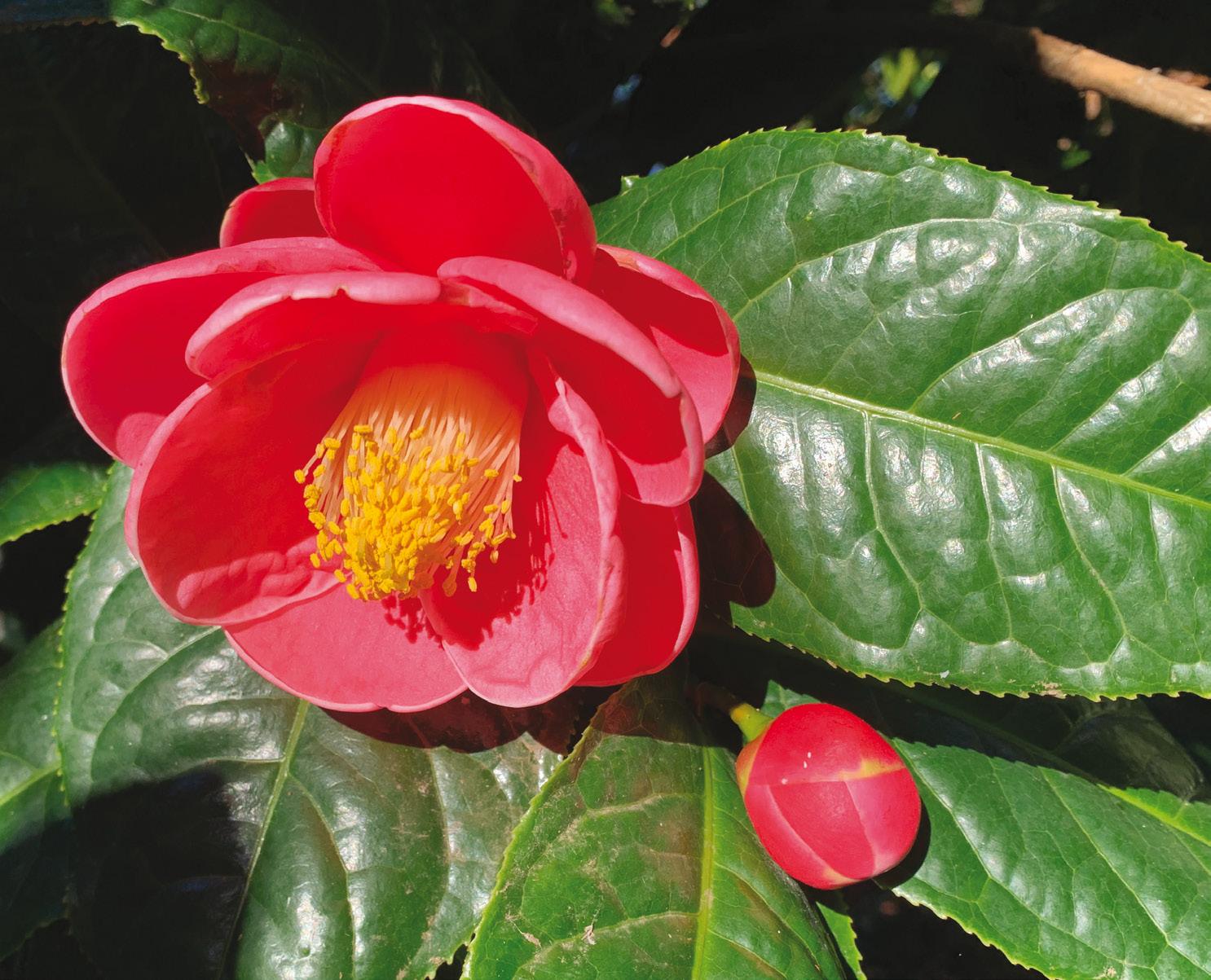
The seasons have come and gone and we are back to the time of year when temperatures and daylight are at their lowest. I mentioned in my column last year that winter is my least preferred season, which is strictly due to the cold weather. However, the diversity that sits within our beautiful Garden ensures there are no bleak moments.
Evergreen conifers are the steadfast guardians of the winter garden as they offer a verdant backdrop against the starkness of the season. Their interesting forms and features infuse the landscape with a sense of permanence and strength. You may have noticed the Araucaria columnaris (New Caledonian pine), which stand tall, albeit on a lean towards the equator – an icon easily recognisable in the green skyline throughout the collection. We have many spectacular conifers, so be sure to spend some time observing them this winter. But what about the flowers? Well, last year we celebrated the magnificent occasion of 200 years of camellias in Australia. Therefore, it’s only fair that I point out a few camellias providing us with the much needed colour fix we are accustomed to. I suggest trying to view the six critically endangered specimens, which are: Camellia azalea, Camellia
cucphuongensis, Camellia flava, Camellia impressinervis, Camellia rosmannii, Camellia rubriflora and the well-known – in cultivation, although extinct in the wild – Camellia amplexicaulis. This last spectacular specimen features large, glossy leaves that can reach up to 30 cm long, and are typical of the tropical and subtropical species from Vietnam. The showy crimson flowers are followed by large woody fruits. I’m pleased to say we are adding further camellias and plants from the Theaceae family to our collection through the renovation of Bed 60. Continue to watch the space develop and establish itself over the next several years.
I recommend making time to enjoy the Oriental Garden this winter. In late June to early July, spend time enjoying Prunus ‘Yvonne Matthies’ (millennium cherry). This hybrid was bred specifically to perform better in warmer climates, such as Sydney, by crossing Prunus avium and Prunus campanulata. There are three mature specimens in Lawn 21a, featuring cerise pink flowers. They are a standout in the landscape, but time your visit carefully as the floral display is short lived, flowering for around three weeks. Don’t worry if you miss out on seeing them, as there are plenty of other amazing plants to enjoy. Jarryd Kelly, Curator Manager

Leaves lying in golden piles and the evergreen features of the gardens provide a contrasting backdrop to the grey, bare limbs of dormant trees. In this landscape, North meets South as two hemispheres converge on Mount Tomah. The North American Woodland display, a unique collection showcasing the biodiversity of North American forests, and the semi-deciduous Nothofagus collection, a testament to the rich flora of our own southern backyard, both grow in cold, moist, montane pockets exposed to occasional winter snowfalls. Though still beautiful, these two collections are not what they once were. Bushfires ravaged these trees, especially the Nothofagus moorei, which is listed on the IUCN Red List as vulnerable.
Due to the microclimates these species require to survive, their repopulation has been slow to combat the fire damage. Without intervention, the BMBG stands to lose collections essential to plant conservation locally and globally, as well as the opportunity to provide valuable education about the world’s climates and the surprising variety of Australia’s native flora.
The BMBG, recognising the gravity of this threat, has forged a crucial partnership with the Global Conservation Consortium for Nothofagus, based at Kew Gardens in England. This alliance, coupled with the funding obtained through the Lorna and Clive Backhouse Scholarship, is a testament to the power of collective action in conservation horticulture. The initiative aims to ensure the longevity of N. moorei, by securing genetically diverse trees from around NSW to be held within our Living Collections. Ash Filipovski, Curator Manager

The Australian Botanic Garden Mount Annan is a site of extremes when it comes to weather. Winter throws its challenges with the cold where on average, we get down to temperatures of 3ºC. Still, it is not unusual for the Banksia Garden to go below freezing and for icicles to form on the barbecue shelters and amenities.
There is always something to see in bloom or on display at the ABGMA but, in winter, there is also a plethora of plants coming into fruit or getting ready for spring. In the nursery, it is a time to take stock of our permanent potted collections. However, for the turf team, the work we undertook in autumn will be coming to fruition with the oversowing of the lawns with a cool seasonal, annual grass, which will keep the lawns green through the winter months. The paper daisies were sown in late autumn and by late winter many will have germinated and will be getting ready for their mass bloom in September.
During autumn, the horticulture team were busy transforming a section of the creek line between the Bowden Centre and the main car park into a beautiful sandstone-lined creek. The aim and scope of this landscaping project has been to improve access for our visitors to our collections, improve sight lines across the landscape, and increase intrigue in the landscape while linking the potential for education engagement in the space. What the team delivered is absolutely amazing, and the background noise of the water cascading over the rocks is always welcome in any landscape.
Michael Elgey, Curator ManagerDuring winter, when deciduous plants are dormant and have lost their leaves, sunshine and warmth are able to penetrate otherwise shady places in the garden that we might not have noticed during the warmer months.
Winter is a wonderful time to enjoy Lonicera fragrantissima (winter honeysuckle), which has highly fragrant, creamy white flowers. This plant grows to about 2.5 m, will tolerate most soil types, full sun and part shade. Other favourites are Helleborus spp. (Lenten rose), Daphne odora and, of course, camellias. Many bulbs also appear in the winter, providing colour and many are perfumed.
A host of Australian native shrubs and groundcovers are flowering, including acacias, banksias, grevilleas, correas, croweas and hardenbergias. One of the most colourful groundcovers,
Lechenaultia biloba (blue lechenaultia), also grows well in containers, especially hanging baskets.
During winter the Botanic Gardens horticulturists are busy in the gardens pruning, weeding and mulching, to give way for new growth in the spring and summer ahead. It is also the perfect time for arborists to assess deciduous trees, reduce tree canopy and remove dead and diseased growth if necessary.
This is also a great time to visit the Growing Friends Nursery for inspiration and to discover the large selection of plants available. Our volunteers love to help with horticultural advice and to point out rare and unusual plants. Don’t forget to look at the new green wall that has now been planted, showcasing some of the plants available for sale.
Belinda Moon, Growing Friends Sydney

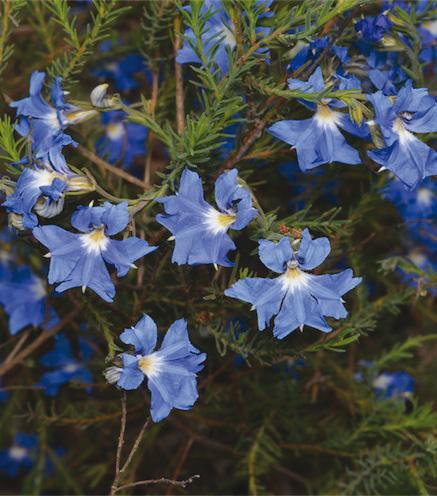
Royal Botanic
– Friday, 11 am – 2 pm
AMAZING OPPORTUNITIES TO FASCINATING DESTINATIONS, OPENING UP EXCITING NEW WORLDS TO EXPLORE. OUR FULLY GUIDED TOURS WILL TAKE YOU ON A WONDERFUL BOTANIC JOURNEY AROUND THE WORLD – ALL WHILE SUPPORTING YOUR BOTANIC GARDENS.
For more information or to book, please visit botanicgardens.org.au/whats-on or contact us at foundation.friends@botanicgardens.nsw.gov.au

RAMBLES AND RHODODENDRONS IN BHUTAN
11 – 22 April 2025
Itinerary now available
Grade: Moderate*
Accommodation: 12 days/11 nights in premium accommodation, including Zhiwaling Heritage in Paro, Zhiwa Ling Ascent in Thimphu and Gangtey Lodge in Gangtey.
After spending two days in Paro acclimatising to the higher altitude, we set off to explore ancient towns, fortresses and monasteries, including a day trip to the iconic Tiger’s Nest Monastery. Enjoy the spring blooming on day walks in rhododendron forests, a visit to the Lamperi Royal Botanical Gardens with a local botanical expert, and beautiful rural valleys. Experience the timeless culture of Bhutan, and its philosophy of Gross National Happiness. A once in a lifetime trip! Other inclusions: All meals
Member price: $17,450 twin share (land content only)
Maximum tour size: 16 guests – very limited. Single-use rooms available
Escort: Relle Mott
Tour operator: World Expeditions

24 April – 4 May 2025
Itinerary now available
Grade: Moderate/Strenuous**
Accommodation: 11 days/10 nights – 4 nights 4/5 star, 6 nights supported, fully catered camping. Experience Bhutan’s classic Druk Path Trek following an ancient trade route through rhododendron forests and alpine spring meadows, past yak-herder camps, over high passes, with fully supported camping beside clear mountain lakes and spectacular views of the eastern Himalayan peaks. After the trek we visit beautiful rural villages and monasteries to learn about the fascinating culture of Bhutan, the Land of the Thunder Dragon. Visit botanic gardens with 46 species of rhododendron and the National Herbarium, which houses around 20,000 herbarium specimens. This small group tour will start and finish in Paro, Bhutan. Other inclusions: All meals
Member price: $13,650
twin share (land content only)
Maximum tour size: 12 guests
Escort: Relle Mott
Tour operator: World Expeditions

Dr Peter Weston worked as a scientist with the Royal Botanic Gardens and Domain Trust and was formerly Senior Principal Research Scientist and now Honorary Research Associate with the National Herbarium of New South Wales. His main research interests are the systematics and biogeography of the families Proteaceae, Orchidaceae and Fabaceae. Peter completed his first tour in 2006 as a visiting lecturer at Rhodes University in Grahamstown in Eastern Cape Province, during which time he fell in love with the country and has subsequently visited South Africa on multiple occasions. He carefully drafts each itinerary to include places he has found to offer biological, geological, horticultural, cultural and scenic interest.
*Moderate: The
NAMIBIA & SOUTH AFRICA
September 2025
Expressions of interest
Grade: Moderate*
Accommodation: 21 nights
This tour will feature the starkly beautiful desert landscapes and fascinating arid-adapted flora of the Namib desert, mass flowerings of intensely coloured Namaqualand daisies, the mind-boggling botanical diversity of the Cape Floristic region, and the fantastic megafauna of southern Africa. From Windhoek in central Namibia, we will drive to the Swarkop River valley then south to the giant sand dunes of Sossusvlei, and the vast Fish River Canyon. Crossing into South Africa, we will travel through the flowering deserts of Namaqualand to the Western Cape and its spectacular fynbos shrublands, rugged landscapes and world-famous botanic gardens. We will finish in Mbombela after a visit to the Greater Kruger National Park.
Escort: Dr Peter Weston

Colombia
We are now taking expressions of interest for a trip to Colombia with Dr Peter Weston in 2026. Please contact us to register your interest.
In a world obsessed with perfection, the misshapen is often overlooked.
Not by Charlotte Thodey, whose life’s work has been built on elevating the ordinary and finding beauty and splendour in the imperfect. It is in Charlotte’s eyes that we find an unlikely and handsome hero in a wonky kohlrabi.
During one of Charlotte’s classes, an unsuspecting visitor may easily find themselves lost in the Joseph Maiden Theatre, or mistake their locale for a bustling flea market. Days before her classes, the space is gradually transformed into a collector’s cornucopia, filled with towering piles of vintage linen, curious jewels of enamelled antiquity and delicate china in every shape, flecked with chips and years of patina,
amid mountains of curiously shaped gourds, brassicas, branches, flowers and fruit. Charlotte scours farmers’ markets, greengrocers and urban streets to find just the right subjects that will inspire and stimulate her students. ‘They love me at the markets, because I love the blemishes, the ones they want to get rid of.’ So dedicated is Charlotte to her vegetables that during 3-day long workshops, she bathes them at night to bring them back to life.
Charlotte recalls her childhood in New Zealand, stealing precious moments with her father, a busy country doctor and father of five, whilst digging in the vegetable garden together. The garden was the place of stories and this was where her love of vegetables began.

An accomplished painter and teacher, Charlotte has a long association with the Royal Botanic Garden Sydney, where she began working in 1983, helping to establish the visitor centre and working on window displays in the gift shop.
In conjunction with Foundation & Friends, Charlotte has delivered countless classes over the years, and has been featured in Foundation & Friends exhibitions such as Harvest, Botanica and at Chateau de Villandry. When asked about her teaching, Charlotte says: ‘I teach how I like to learn, not just by giving a list of rigid instructions. I want them [my students] to find their own way of seeing things.’ Her careful tutelage inspires a sense of curiosity and independence. Charlotte shepherds her students to find the light, often jauntily debating with them about what they see in front of them. ‘It takes courage and playfulness to give up total control, to watch the alchemy of the paint, and know when to stop.’ More than just a teacher, Charlotte guides her pupils and helps them to capture a moment in time.
Charles Guillan has attended many of Charlotte’s workshops over the past decade as a regular visitor to the gardens. ‘Charlotte is an excellent teacher; she is motivating and inspiring. The biggest thing I have learnt from Charlotte is the importance of tone, the contrast between dark and light. Through my continued work with her, I have honed my ability to mix colours and have learnt the art of composition. Most importantly, she has shown me how to really observe.’ Join Charlotte on her next workshop for more information see page 33.

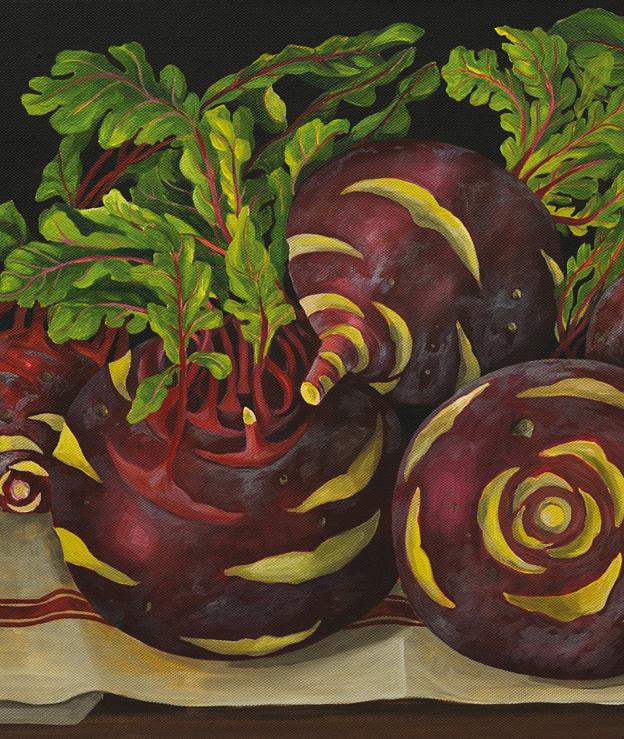


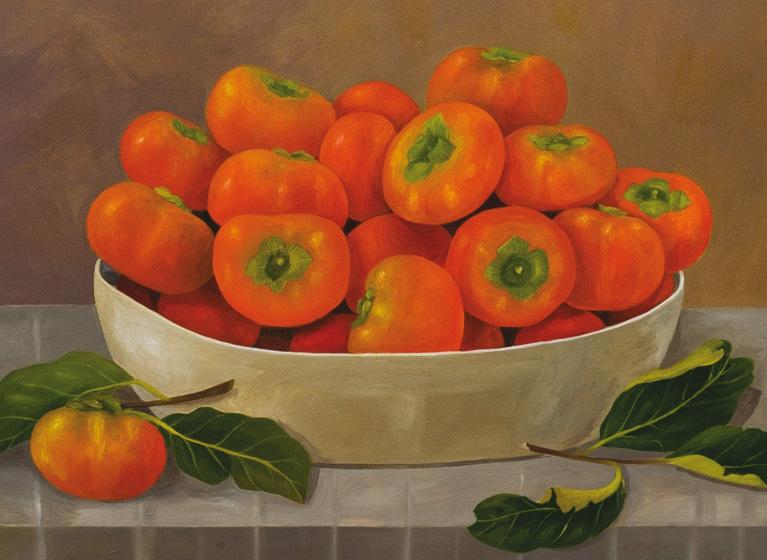


LIGHTSCAPE RETURNS TO THE ROYAL BOTANIC GARDEN SYDNEY IN WHAT PROMISES TO BE A DAZZLING SHOW OF LIGHT AND MAGIC. CSILLA SWAIN REPORTS.

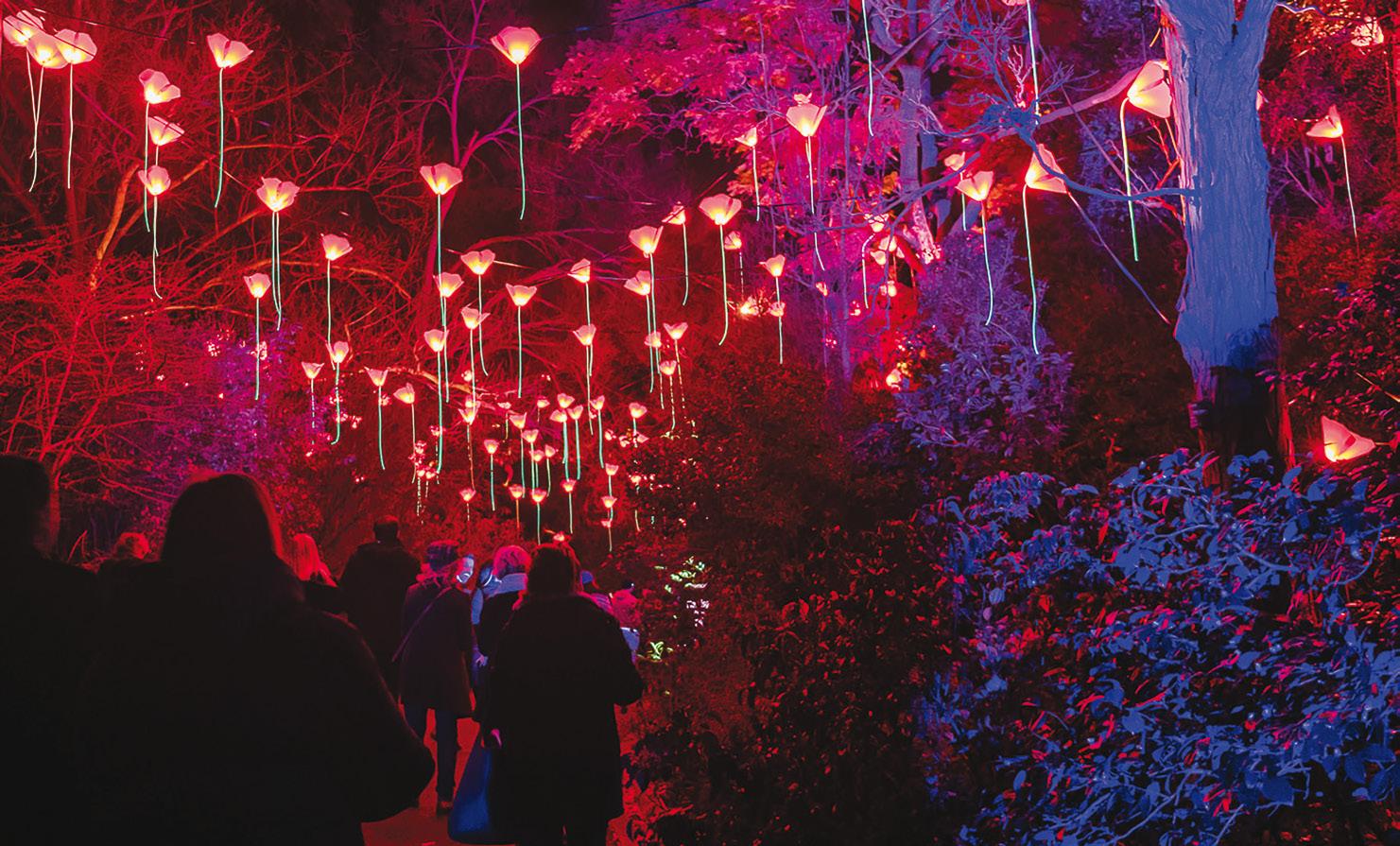
The Royal Botanic Garden Sydney is thrilled to once again be hosting Lightscape, an illuminating international sensation, which will light up the Garden in a technicolour wonderland from 25 May to 14 June as part of the celebrated Vivid Sydney.
Together with Sony Music Entertainment, Vivid Sydney presents an immersive all-ages experience, designed by leading UK-based creative agency Culture Creative, to transform the landscape into shining moments of wonder.
The self-guided, 1.8-km walk follows a trail along the harbourside, then through glowing tunnels and undergrowth. Expect to see the Garden in an entirely new light!
‘Vivid Sydney 2024 is diving deep into what makes us uniquely human, designed to foster connections, spark imagination and showcase the multitude of ways creativity enriches our lives. We are so excited to welcome back Lightscape to Vivid Sydney 2024’ says Vivid Sydney Festival Director, Gill Minervini.
Wander beneath gravity-defying dandelions in Light a Wish, or marvel at suspended flowers in Floraison, then admire the Glowing Neon Outline Trees, before delighting in crowd favourite, Winter Cathedral
Chair & CEO of Sony Music Australia and New Zealand, Vanessa Picken, says: ‘Lightscape has captivated audiences of all ages in botanic gardens from the US to UK and throughout Australia. Its highly anticipated return to Sydney
Its highly anticipated return to Sydney will bring with it all-new lightworks, soundtracks and immersive experiences.
will bring with it all-new lightworks, soundtracks and immersive experiences.’
Culture Creative Managing Director, Zoe Bottrell, explains: ‘Each Lightscape trail that Culture Creative designs and builds is unique and we know the trail we’ve produced for Sydney this year will enchant new audiences as part of Vivid Sydney, and charm those who attended last year.’
Foundation & Friends CEO, Pete Thomas, welcomes the installation, and reflects that ‘Lightscape has been hugely successful around the world, and events such as these bring new audiences into botanic gardens during a time when they would otherwise be closed’, and remarked that ‘not only is it an amazing site to host such an exciting event, it raises awareness and vital funds, and provides an opportunity to engage with nature in new and different ways’.
24 May – 15 June 2024
Royal Botanic Garden Sydney LightscapeSydney.com.au
For more information, see this issue’s Diary, page 31.

Here is just a taste of what is on offer across our three Gardens. For more information about events, and to book, visit botanicgardens.org.au/Whats-On, scan the QR code on this page or phone us on (02) 9231 8182.
BONSAI & IKEBANA
The Garden Gallery
Royal Botanic Garden Sydney
Enter via Mrs Macquaries Road Fri 13 – Sun 15 September 10 am – 4 pm, Free
This spectacular exhibition is being held to celebrate passionate bonsai and ikebana artist, teacher, demonstrator and lecturer Megumi Bennett‘s amazing 50 Years of Bonsai and Ikebana in Australia, and the 25th Anniversary of the Bonsai Society of Sydney, which she founded in 1999. The very best of bonsai will be on display, including a 130-year-old, 65 cm tall Atlas cedar (Cedrus atlantica) and a magnificent 75-year-old, 1 m tall Japanese red pine (Pinus densiflora). Trident maples (Acer buergerianum), Japanese black pines (Pinus thunbergii) and Port Jackson figs (Ficus rubiginosa), to name just a few, will also be exhibited.
Bonsai is the art of growing miniature trees and shrubs in containers, which is achieved by pruning the plant’s stems, branches, new shoots and roots, and shaping the plants so they appear as they would in nature. Bonsai is a Japanese word meaning ‘planted in a tray’. However, the art form originated in China and potted plants were depicted in poems and paintings going back to the Tang and Song Dynasties (618–1279). In Japan, the first mention of bonsai appears in the Kamakura period (1192–1333), and the Japanese have developed their own form of bonsai, which they then introduced to the Western world. Many tree species lend themselves to the art of bonsai, including Australian natives. Bonsai come in many sizes, and in addition
to large bonsai, in the exhibition there will be excellent examples displayed of small and miniature bonsai from 5–20 cm tall. To grow bonsai you need a little bit of horticultural knowledge and artistic talent, but if you think you don’t currently have this expertise, don’t worry as you will develop these skills during the process of growing your bonsai. Your love of nature and trees will be enhanced, and your bonsai will soon become a member of your family and part of your daily life. Ikebana is the ancient and classical art of Japanese flower arranging. It is considered that the origin of ikebana goes back to when ancient people offered lotus flower arrangements as a way of
honouring Buddha. The first ikebana school in Japan was founded in the early 7th century. The exhibition will display colourful examples of ikebana, ranging from beautiful examples of the classical style, established in the 18th century, to modern contemporary designs. What both bonsai and ikebana have in common is that they are symbols of peace, harmony and strength, and they help us escape the constant distractions, noise and stresses of today’s modern life. So, the Royal Botanic Garden Sydney is the perfect place to hold this beautiful exhibition. Megumi Bennett, Honorary Patron, Bonsai Society of Sydney
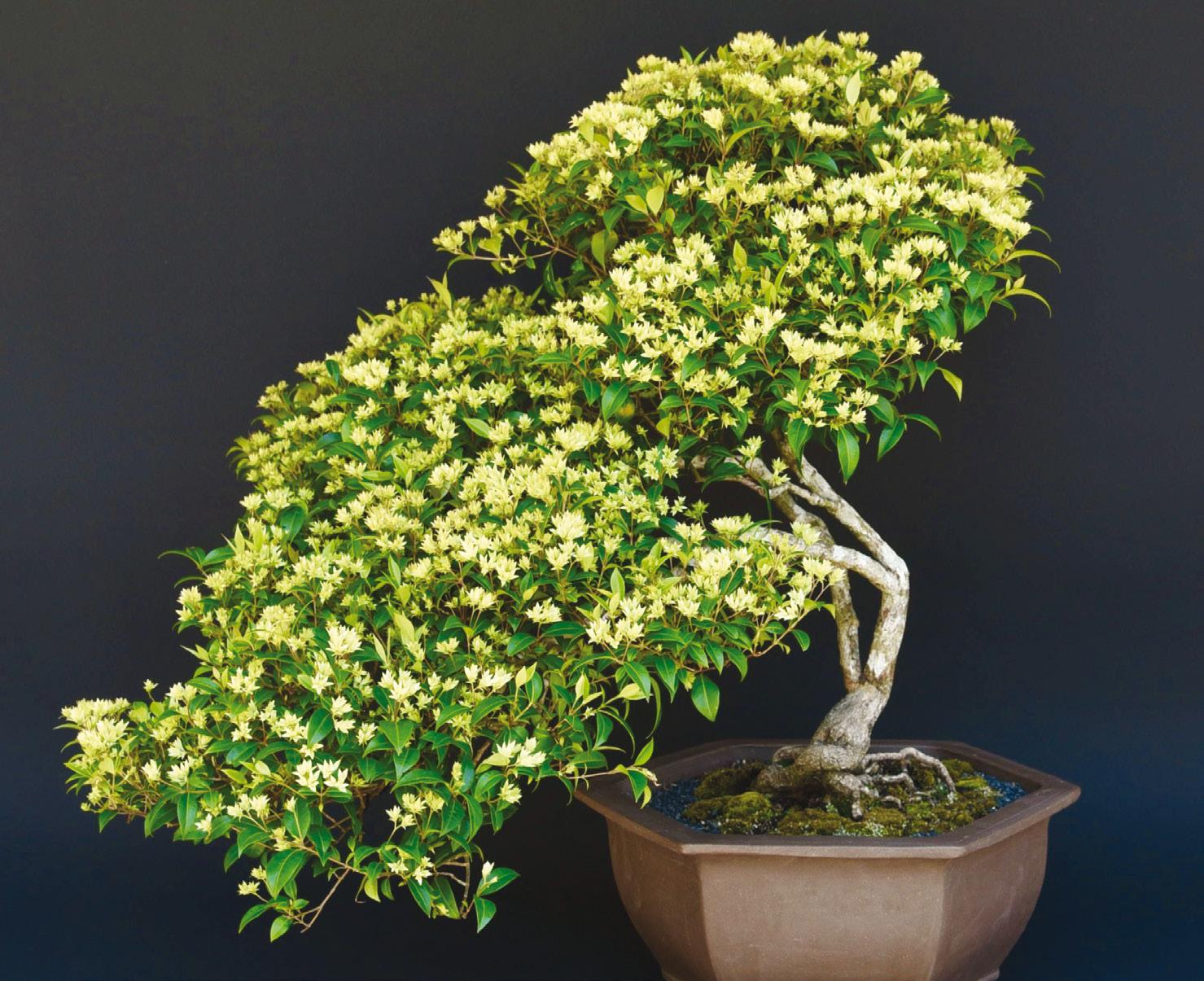
 by David Van Nunen
by David Van Nunen
The Garden Gallery, Royal Botanic Garden, Fri 5 – Tue 23 July, 10 am – 4 pm
The Australian Watercolour Institute (AWI) returns to the Royal Botanic Garden Sydney this July with an exhibition comprising over 150 works, its theme exploring art’s relationship to the pleasures of nature. It’s hardly surprising to anyone who harbours a love of the botanical that Eden, the fabled garden of earthly delights, takes its name from the Hebrew term for pleasure. Founded in 1923, the AWI is the country’s first and foremost national society of professional watercolourists whose membership has comprised many of Australia’s and the world’s most eminent artists. This AWI 100th Annual Exhibition continues their centenary celebration, featuring renowned botanical artists such as Deirdre Bean, Beverly Allen, Colleen Werner and Julianne Ross Allcorn, as well as one of China’s foremost watercolourists, Xidan Chen. Entry by donation.
 by Jeannie Baker
by Jeannie Baker
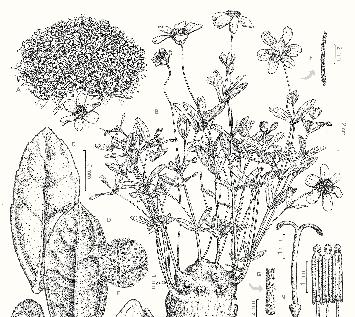
JEANNIE BAKER: DESERT JUNGLE
The Garden Gallery
Royal Botanic Garden
Enter via Mrs Macquaries Road
Until Sat 29 June, 9.30 am – 4 pm
Explore Jeannie Baker’s spectacular and astonishing collages capturing the deep beauty, mystery and hidden vitality of the desert landscape –and why it needs our protection. Over one-third of the Australian landscape is classified as desert, and yet for most settler Australians, the desert remains a barren space.
Free

Royal Botanic Garden
Until Sat 15 June, Timed in 15 minute increments from 5 pm onwards 90 minutes recommended Lightscape, the multisensory phenomenon of light, colour and sound returns, reimagined in 2024. Wander beneath illuminated canopies, stroll under larger-than-life flowers and through dynamic, glowing tunnels. Discover moments of wonder in the Garden at night.
Tickets: LightscapeSydney.com.au
From $38
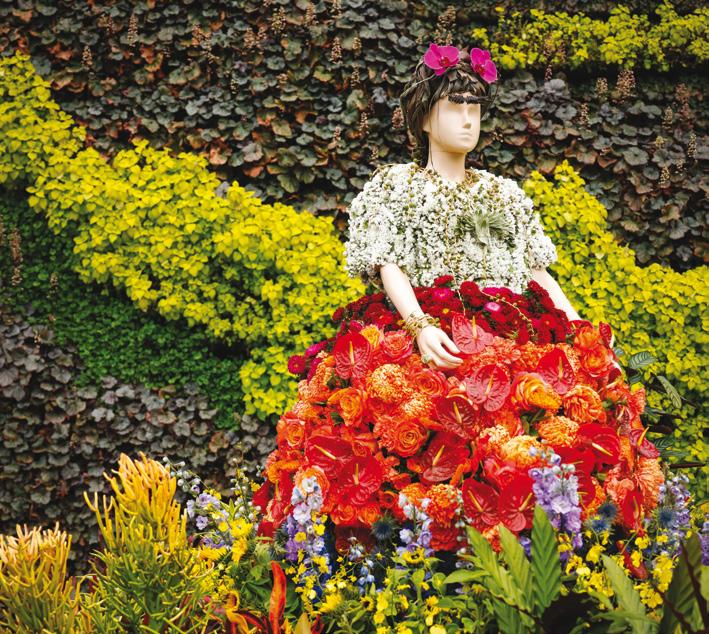
THE MARGARET FLOCKTON AWARD EXHIBITION
The Garden Gallery
Royal Botanic Garden
Enter via Mrs Macquaries Road
Fri 2 – Sun 25 August, 10 am – 4 pm
The 21st Margaret Flockton Award exhibition returns, showing in the newly opened Garden Gallery. Be immersed in the highly detailed scientific botanical illustration alongside the work of the Gardens’ first illustrator, Margaret Flockton. Entrants to the award display a diverse array of styles and mediums.
Free
The Calyx, Royal Botanic Garden Fri 9 – Sun 18 August, 10 am – 4 pm
Join us for the enchanting journey of VOYAGE, as The Calyx transforms into a garden of wonder and creativity. Following its global tour, VOYAGE arrives in Sydney with 15 breathtaking floral mannequins, each a unique masterpiece crafted by Sydney’s finest florists. Immerse yourself in this floral extravaganza at your own pace, or be inspired with talks and demonstrations by expert florists and horticulturists.
From $25

The Calyx, Royal Botanic Garden Tue 18 Jun, 6.30 – 9 pm
Join us for a night of astronomy and stargazing at The Calyx in the heart of the Royal Botanic Garden
Over a glass of wine, understand the cultural significance of the night sky with First Nations astronomer Drew Roberts from Shared Knowledge, then travel through space to visit mysterious planets far from Earth with renowned astronomer Dr Angel Lopez-Sanchez.
Suitable for 12+. From $37

The Calyx, Royal Botanic Garden Sun 11 August, 10.30 am – 12 noon
Orchids are the world’s second-largest family of flowering plants, and they have fascinated, entranced and excited people for generations with their beautiful blooms. Find out who else these flowers attract and learn more about how to grow them with a tour of orchids in the Royal Botanic Garden’s Nursery by specialist orchid volunteer Peter D’Olier and fellow orchid judge and volunteer guide, Jane D’Olier. From $30

GHOSTLY GARDEN
Woolloomooloo Gate
Royal Botanic Garden
Fri 28 June, 26 July & 9 August
Times vary according to sunset
Take a twilight adventure through the Garden in this spine-tingling event. Journey along shadowy tree-lined paths and hear spooky stories of strange happenings from the Garden’s past, as flying foxes flit above your head and night creatures stare from the treetops. Suitable for 12+. Under 18s must be accompanied by a paying adult.
From $37

ABORIGINAL HARBOUR
HERITAGE TOUR
with First Nations guides
Visitor Centre, Royal Botanic Garden
Every Thu, Fri, Sat (excl. public holidays), 11 am – 12 noon
Our First Nations guides will immerse you in the rich Aboriginal culture of the traditional custodians of the Sydney city area, the Gadigal. Stroll along the Sydney Harbour foreshore and listen to stories of Gadigal lifestyle, traditions, history and connection to country and community.
From $27
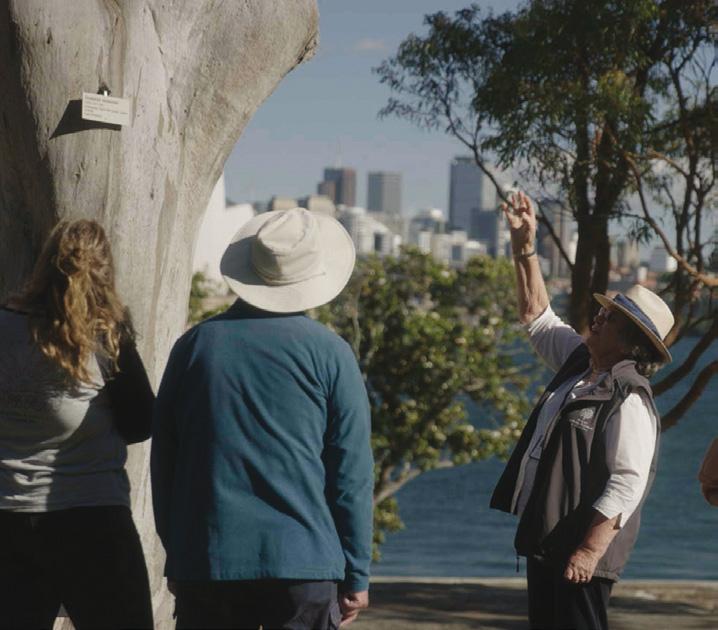
BARK – BEAUTY, BOUNTY & BOTANY
Maiden Theatre, Royal Botanic Garden
Sun 28 July, 10 am – 12 noon
Join us on National Tree Day for a walk through the Gardens, exploring all things bark. We’ll begin with a short presentation where you’ll learn how and why a tree produces bark, and explore its role as a habitat for plants and animals. Following, we will visit fascinating trees in our Garden’s collection to enjoy their beauty, and to learn how for thousands of years, we’ve relied on bark to feed us, cure us and inspire us. Morning tea included.
From $40

ABORIGINAL BUSH TUCKER
with First Nations guides
Visitor Centre, Royal Botanic Garden
Every Thu, Fri, Sat (excl. public holidays), 1 – 2 pm
Walk with a First Nations guide to learn more about Indigenous bush foods and how they were used traditionally and adapted to the modern plate and palate. You’ll also take in the Cadi Jam Ora garden to learn about some of the hottest bush foods on the market, all while tasting some goodies for yourself.
From $27
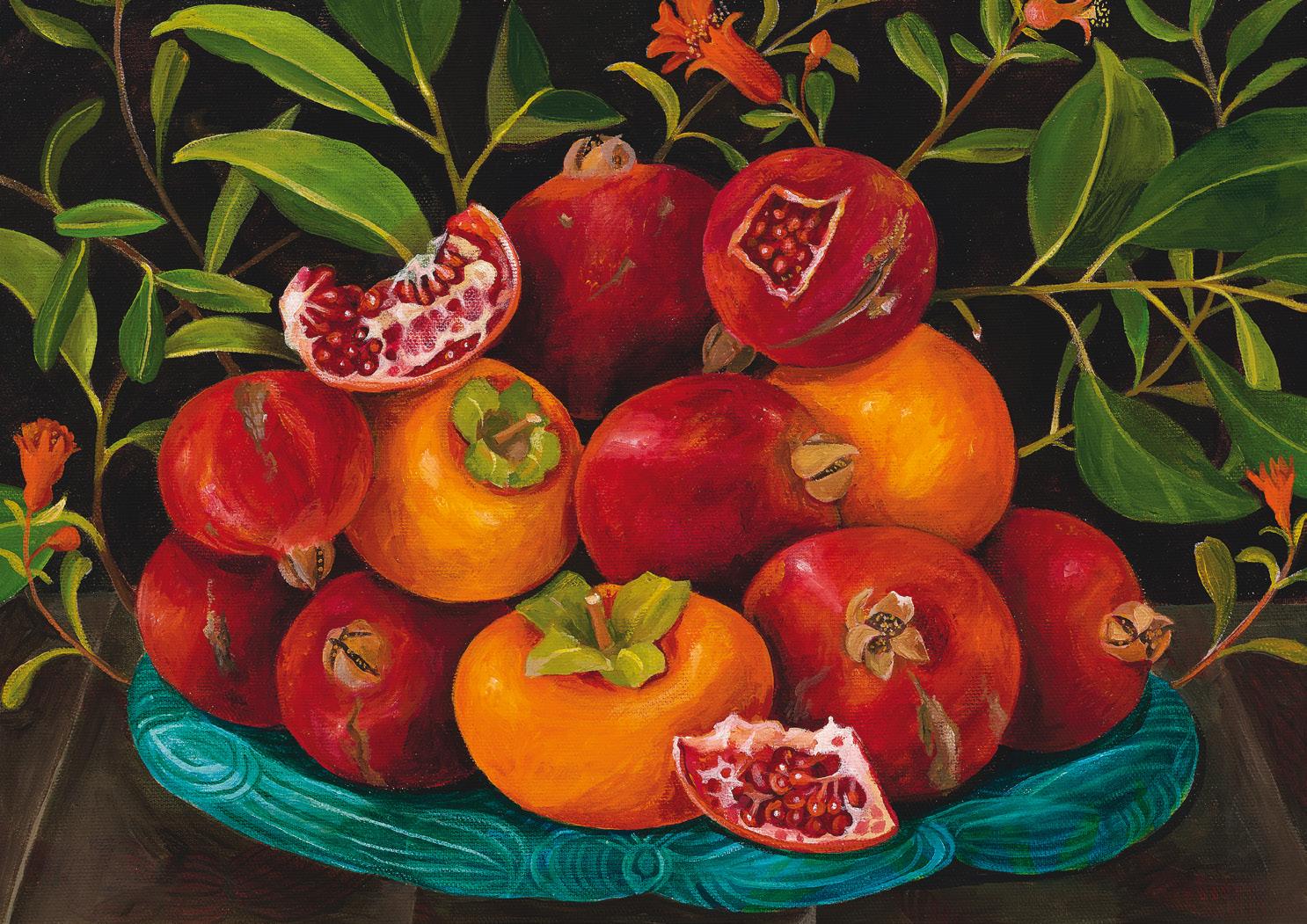
A PALETTE OF PRODUCE with Charlotte Thodey Maiden Theatre, Royal Botanic Garden, Wed 19 – Thur 20 June, 9.30 am – 4 pm
A practical search for solutions in the still life genre with an emphasis on composition, tone and colour. Explore your individual style, ranging from a loose open brush to finely detailed work. You’ll be making use of seasonal fruit, foliage, vegetables, china and linen as props. Learn to make big decisions about small things and clear the mind. Lunch and refreshments will be provided each day. From $340

SEASHELLS AND MOLLUSCS with Anna Voytsekhovich Maiden Theatre, Royal Botanic Garden, Wed 3, Fri 5 July, 9.30 am – 4 pm
During the workshop participants will learn new and interesting facts about Australian marine life. They will reveal a microstructure of a chosen marine organism and will have a chance to draw what they see. And most importantly, they will learn how to produce a scientifically accurate tonal drawing and a beautiful watercolour illustration of a seashell or mollusc. From $400

LIFE DRAWING IN THE PALM HOUSE with Gladdy Drawing Club
Palm House, Royal Botanic Garden Sat 22 June, 2 – 4 pm
Gladdy Drawing Club brings their iconic body-positive life drawing classes to the oldest glasshouse in NSW, the Palm House, Royal Botanical Garden Sydney. Explore your creativity in the charm of the Palm House while you sketch the model. All skill levels are welcome, materials are provided, and tickets include complimentary wine from our partners, Taylors.
From $55
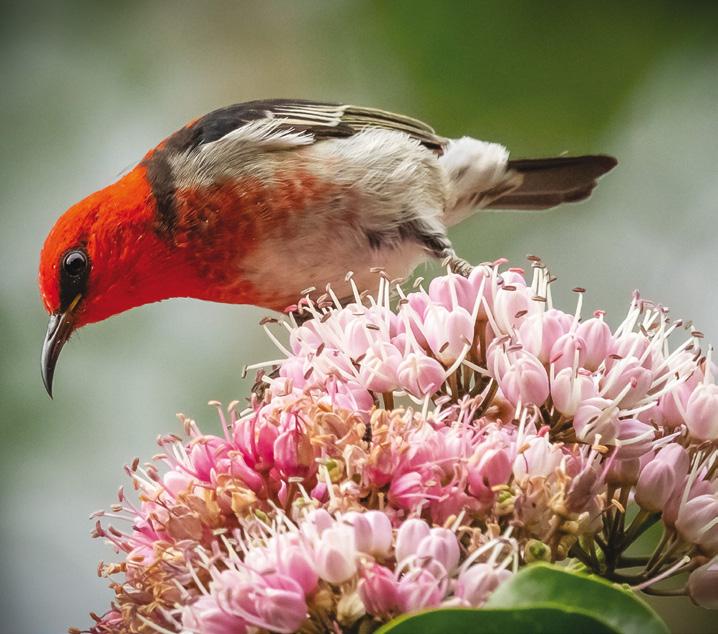
NATURE PHOTOGRAPHY with Glenn Smith
Australian PlantBank, Australian Botanic Garden
• Bird photography
Sun 16 June, 8.15 am – 1 pm
• Beginner
Sun 14 July, 8.15 am – 1 pm
These workshops will cover the many varied aspects of improving your nature photos. Learn to use your camera with an award-winning photographer who has been running photography classes in the Garden for many years.
From $120

Did you know that people who volunteer experience higher levels of happiness and wellbeing? Here at Foundation & Friends, there are many ways to get involved. We have nine volunteer programs that could use your skills and expertise. Volunteering not only helps support our thriving, connected community that supports the Gardens, it also contributes directly to fundraising. You will learn new skills, meet like-minded people and be part of something special – not to mention enjoy the health benefits! There are myriad ways you can be part of our wonderful community, \and we look forward to welcoming you. To get involved, contact our Volunteer Coordinator on (02) 9231 8182, visit botanicgardens.org.au or scan the QR code.

Robert Brown Building
Royal Botanic Garden Sydney Tue 19 November, 5.30 pm We encourage members to attend. It is an excellent opportunity to hear an update on the work of Foundation & Friends. We will be holding a light supper after the Annual General Meeting to thank and celebrate our volunteers. The agenda for our 42nd Annual General Meeting will include elections for vacant Board positions and an update on achievements. Contact the Foundation & Friends office via email foundation.friends@ botanicgardens.nsw.gov.au or on (02) 9231 8182 if you require any further information.


Leave a lasting legacy and shape the Botanic Gardens’ future. Contact Foundation & Friends on (02) 9231 8182, visit botanicgardens.org.au or scan the QR code.




Experience flowers like never before...
9 – 18 AUGUST
Embark on a floral journey of discovery around the world with spectacular fresh floral mannequins inspired by global destinations, all created by Sydney’s talented florists.
BOOK NOW: botanicgardens.org.au/ fleursdevilles

Foundation & Friends of the Botanic Gardens Ltd, Cottage 6, Mrs Macquaries Road, Sydney 2000 Phone: (02) 9231 8182
Chief Executive Officer: Peter Thomas foundation.friends@botanicgardens.nsw.gov.au botanicgardens.org.au/foundation-and-friends Office hours: Mon – Thu, 9 am – 3 pm facebook.com/FoundationandFriends instagram.com/FoundationandFriends
EDITORIAL
Acting editor: Csilla Swain
Acting copy-editor: Ariana Klepac
Designers: Lauren Sutherland, Swell Design Group
Feature writers: Prof. Brett Summerell AM (Botanical Science), John Siemon (Horticulture), Michelle Leishman (Research), Karen Sommerville (Rainforest Seed Conservation), Miguel Garcia (History), Dom Sweeney (First Person), Csilla Swain (Exhibitions & Profile)
Contributors: David Bidwell, Pete Thomas, Michael Elgey, Ashley Filipovski, Jarryd Kelly, Belinda Moon, Barbara Forward, Megumi Bennett, Richard Chaplin, David Van Nunen, Joe Bidwell, Lily Durland, Michelle Burke
Text and design © Foundation & Friends of the Botanic Gardens
Printer: Bright Print Group
Print Post approved: PP 100004091 ISSN 1324-8219
Printed in Australia on paper made from FSC-certified and other controlled materials.
FSC® helps take care of the forests, and the people and wildlife that call them home.
ACKNOWLEDGEMENT OF COUNTRY
We honour and respect all Elders and Traditional Custodians of the lands on which the Botanic Gardens of Sydney and Foundation & Friends stand.
Before Sydney, this land was known as Woccanmagully, cared for by the traditional custodians, the Gadigal of the Eora Nation. We acknowledge the profound significance of the enduring connection between the First Custodians and this land, recognising their vital care and stewardship for their country and its significance to all who cherish and share in it.

Can you imagine a future without rainforests?
End of Financial Year Appeal
Donate before 30 June
Our Australian rainforests are under serious threat battling three major challenges: myrtle rust, climate change and deforestation. With your support, Botanic Gardens of Sydney will be able to continue the important work to save our critically endangered rainforest species from extinction.
Join us in our mission to rescue, restore and renew our rainforests, ensuring a future where they thrive for generations to come.